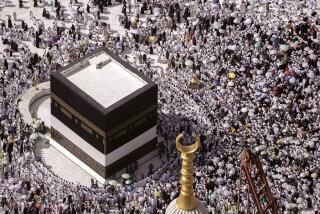Ancient tale transports a 21st century traveler
- Share via
SOMEDAY I would like to see the Empty Quarter in the Arabian Desert; the Syrian trading entrepot Aleppo; the ancient Persian capital of Esfahan; Central Asia’s Tien Shan mountains; Borobudur Temple on the island of Java; the Vale of Kashmir in the Himalayas; Mecca; all the great sights of Dar al-Islam, historically a broad swath of Eurasia and Africa that was converted and colonized by followers of Muhammad.
Such places are relatively new entries on my must-see list, inspired by a book I just discovered, “The Adventures of Ibn Battuta: A Muslim Traveler in the 14th Century.”
In it, author Ross E. Dunn, a San Diego State University history professor, tells the story of an amazing, 24-year road trip that took Battuta, a young legal scholar, from Morocco to China in the 1300s. The irony is that I found Dunn’s book and started hankering to see Dar al-Islam’s landmarks at an inopportune time for traveling there.
“The Adventures of Ibn Battuta” was first published in 1986 and came out this year in a new, revised edition. It spins a wild but apparently true yarn about a trip that roughly paralleled but in many ways surpassed that of Marco Polo, the Venetian merchant who took to the road a generation before Battuta. Both left books about their wanderings -- the “Book of Marco Polo” and Battuta’s “The Rihla.”
Battuta’s was a sort of travelogue intended for the Muslim intelligentsia and was unknown to Westerners until the 1850s when two French priests discovered several almost-complete copies in Algeria.
Although “The Rihla” has been translated into English, it is apparently a difficult read for nonacademics. So, Dunn wrote a version of the narrative, enhanced by the accounts of other medieval travelers, and his own knowledge of history and geography and travel observations.
Battuta set out from his birthplace of Tangier, Morocco, at the western edge of Dar al-Islam, to make the pilgrimage, or hajj, to Medina and Mecca, a sacred duty for all able believers.
The 21-year-old crossed North Africa by hooking up with trade and diplomatic caravans; stopped in Cairo, the intellectual and cultural capital of the Muslim world at the time; then detoured north to Jerusalem and Damascus.
Along the way, Battuta met scholars, state officials and holy men who gave him food, lodging, camels, clothes, slaves and the occasional purse of gold, a wayfarer’s due, according to the Koran. With little trouble, Battuta made it to Mecca in about 19 months, where he performed the proscribed rites, listened to scholarly lectures, socialized and rested. And then he simply kept wandering.
He tramped across the Arabian Desert to such fabled Persian cities as Esfahan and Shiraz, both in present-day Iran, hopscotched down the eastern coast of Africa by boat, turned north across present-day Turkey, then wandered into the steppes of Central Asia, ancestral home of the Mongols, who had conquered most of Eurasia in the century before Battuta was born.
India was next on his peripatetic itinerary, by way of the Hindu Kush and the Indus River. He made a fortune working for a sultan in New Delhi, then lost it in a shipwreck on the Malabar Coast of eastern India that left him with only his trousers.
Southwest of the subcontinent, on the Maldive Islands, Battuta hobnobbed with royalty and fomented revolution. In Ceylon (now Sri Lanka), he climbed Adam’s Peak, holy to Buddhists, Hindus and Muslims. On a sailing ship, he passed through the Strait of Malacca, a lair of pirates, and reached the eastern coast of China, where he finally turned around.
On the way home, he traveled west from the Orient into the path of the Black Death, which struck the Mediterranean basin in 1348. The plague killed untold millions in the Eastern Hemisphere, but it did not get Ibn Battuta. He returned fit and ready for a last trip across the Sahara Desert to the Islamic African empire of Mali before finally settling down to the humdrum life of a provincial judge in Morocco.
It wasn’t just Battuta’s itinerary that fascinated me. I was amazed to find that anyone could have traveled so widely before airplanes, wheeled luggage and frequent-flier miles. Moreover, I put the book down thinking of the world differently, reoriented geography and history.
I had studied medieval Europe ethnocentrically but now can only conclude that during Battuta’s time, it was a cultural, political and technological sideshow. In the 14th century, the main event was Dar al-Islam.
Getting me to think globally seemed an extraordinary feat, so I decided to talk with Dunn, the author and historian who accomplished it.
Why has everyone heard of Marco Polo but not of Ibn Battuta?
The easy answer is that education in the U.S. is centered on the study of Western civilization. Marco Polo was a European. He came to be seen as an icon of discovery, a precursor to Christopher Columbus, someone who opened up Asia to trade.
Of course, that’s complete nonsense. Muslims started traveling and trading in Asia as early as the beginning of Islam in the 7th century.
“The Rihla” is one of the most important and extensive documents about what happened in Afro-Eurasia during the second quarter of the 14th century.
For a long time, it was only known to Orientalists, but now Ibn Battuta has begun to find his way into world history textbooks.
What was Pax Mongolica and how did it affect Battuta’s travels?
Pax Mongolica refers to the period between 1250 and 1350 when four large, stable Mongol kingdoms existed that stretched across the Eastern Hemisphere.
That doesn’t mean there was peace everywhere, because Mongol states were always fighting each other. But in that period, there was a surge in long-distance commerce along the silk routes and across the Indian Ocean.
Besides relative peace in much of the Eastern Hemisphere, what kept Battuta traveling for a total of almost 30 years?
First of all, he wanted to make the holy pilgrimage to Mecca. He traveled to study and visit living Muslim saints. He went to India explicitly to look for a job. ... On the frontiers of Islam it was easier for an Arabic speaker with some Koranic knowledge to get ahead. Finally, I’d have to say he went all those places just because they were there.
After spending so much time with Battuta, did you come to like him?
I couldn’t help it. He was such an operator. I’m sure he was very charming, a raconteur, good at ingratiating himself with power. But I sometimes found him annoying. He could be prissy and prudish and kept trying to present himself as an accomplished Muslim scholar.
Young women in my classes tend not to like him. He abandoned a series of wives and kept slave girls, so they see him as a bounder and cad.
Does studying Battuta inspire your students to think differently about the world and to travel?
I certainly encourage them to. I’ve seen students at the beginning of semesters in London, scouring the city for a Taco Bell. At first, they don’t know how to handle the culture of England. They don’t have the mental architecture for thinking about a larger world.
A California student once told me he got a job for the summer “back East.” When I asked him where, he said Phoenix.
But young Americans need literal and figurative maps that encompass the world if they are to function in the 21st century.
Have Sept. 11, the war in Iraq and U.S.-Islamic antipathy made them less interested in the Muslim world?
Many people want to learn more about Islam now. You might have thought that my book would drift slowly into oblivion, but it hasn’t.
Susan Spano also writes “Postcards From Paris,” which can be read at latimes.com/susanspano.
More to Read
Sign up for our Book Club newsletter
Get the latest news, events and more from the Los Angeles Times Book Club, and help us get L.A. reading and talking.
You may occasionally receive promotional content from the Los Angeles Times.










